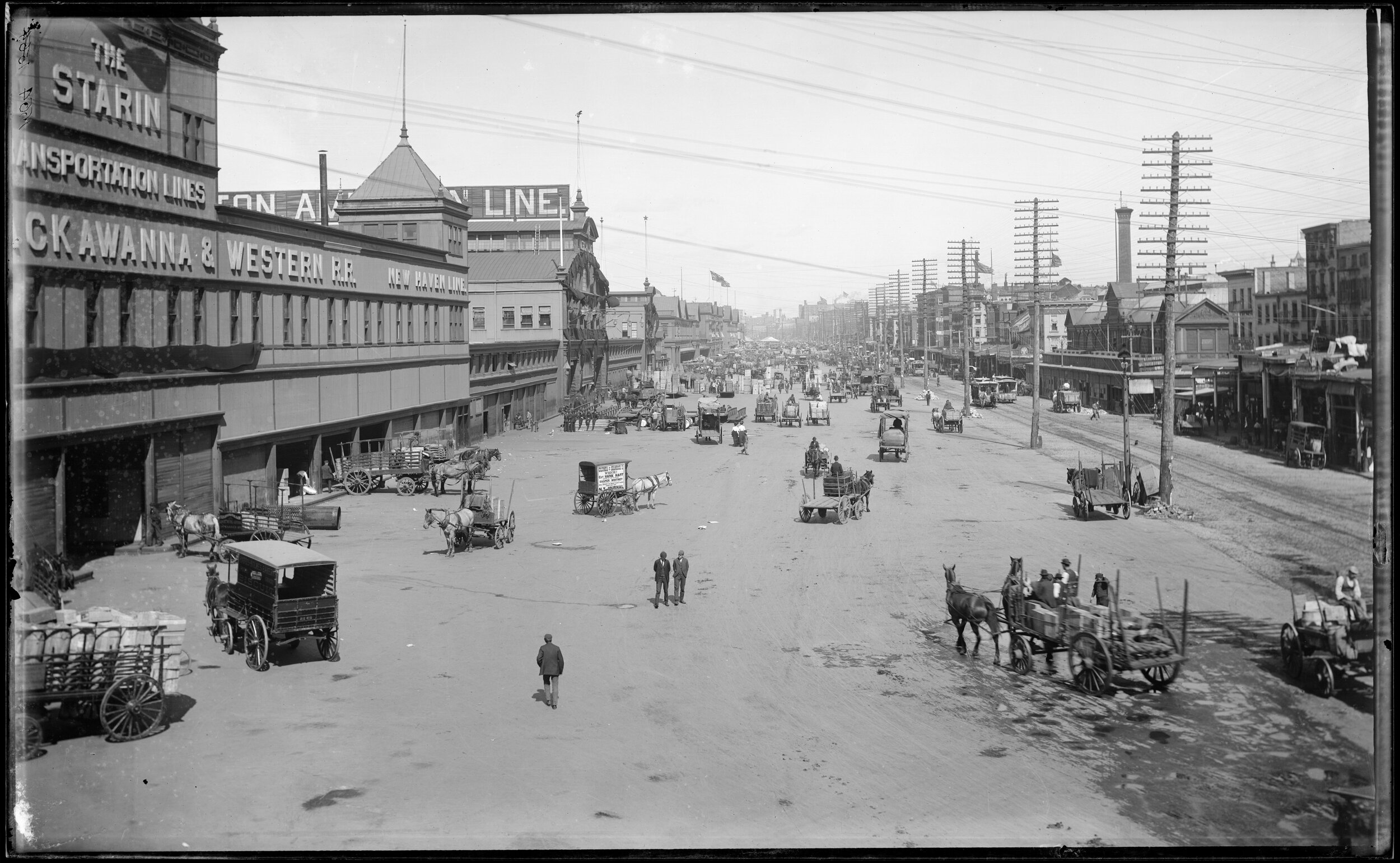Recent blogs have discussed how the increasing importance of the mayor within city government over the course of the 19th century is reflected in the quantity and significance of mayoral records in the Archives. This week we will focus on the “Letterpress Volumes,” an important but often overlooked series related to the mayoral correspondence collections, collectively known as the “Early Mayors Papers.”
In their preface to Gotham, the essential history of New York City, authors Mike Wallace and Edward Burroughs neatly encapsulated the city’s trajectory over the course of the 19th century:
“New York was a place of ever-increasing potency in global affairs, and as the United States evolved from colony to empire, the city migrated from the edge to the center of the world.”
Commercial maritime activities focused on Manhattan’s west side waterfront were the primary engine of the city’s economy in the 19th century. West Street, Manhattan, ca. 1900. Department of Docks and Ferries Collection. NYC Municipal Archives
New York City has always played a central role in the nation’s economy. In 1850, the port of New York handled more goods and passengers than all others in the country combined. By the end of the century it had become the busiest port in the world. Similarly, the city’s financial markets and banks were a conduit for capital to finance industrialization and westward expansion across the continental United States.
John Fitzpatrick, Mayor of New Orleans, to Mayor of New York. Letter, August 5, 1893. Mayor Thomas Gilroy Collection, NYC Municipal Archives.
During the latter part of the 19th century American railroads and industry experienced a wave of consolidations and vertical integration that resulted in the creation of the modem corporate enterprise. Many of these new businesses found New York City to be a highly desirable location for their national headquarters. Not only did the city provide access to capital funds, but it fostered an economy of legal, managerial, and advertising services. Advances in building technology, particularly the elevator and steel-frame construction, enabled construction of tall office buildings. With abundant steam heat supplied from central power stations, reliable electric and telephone service, plus a growing transit system for the working population, the city quickly become the nation’s premier commercial center. Massive immigration during the latter part of the century challenged city government as never before in all areas of municipal services including health, housing, sanitation, care for the destitute, transportation, education, and policing.
The growing centrality of the mayor in city government is reflected in the intellectual content of the mayoral records. Mayoral correspondence provides ample evidence of how the office interacted with the business, labor, social, and other constituent communities of the city, and how they used the powers of municipal government—taxation, regulations, expenditures—to shape the destiny of the city and the nation.
Letters from city officials from around the country asked New York’s mayor for advice and information. In 1877, Mayor Smith Ely received communications from Milwaukee, Norfolk, St. Louis, Philadelphia, and Detroit, each soliciting answers to questions about municipal administration. The Mayor of Milwaukee wanted to know: “...what [is] the opinion of the people residing on lines of the railways in respect to the use of steam?” In 1893, mayors from Chicago, Portland, and New Orleans similarly wrote to Mayor Thomas Gilroy for advice. John Fitzpatrick, Mayor of New Orleans, inquired “...has your city an asylum or place of refuge (not strictly prisons) where persons are committed...” and, “if the said institution have any industry in connection therewith that make them self-sustaining or nearly so.”
John McCarthy, Superintendent of Streets, City of Chicago to Mayor of the City of New York. Letter July 17, 1893. Page 1 of 2. Mayor Thomas Gilroy Collection, NYC Municipal Archives.
John McCarthy, Superintendent of Streets, City of Chicago to Mayor of the City of New York. Letter July 17, 1893. Page 2 of 2. Mayor Thomas Gilroy Collection, NYC Municipal Archives.
Researchers exploring these and other topics in American history will find the Early Mayors Papers supplies endless examples to support their arguments. But eventually they might notice that they are seeing only the incoming correspondence. Where are the replies?
The answer is that copies of letters written in reply were maintained in “Letter Press” volumes. There are 165 volumes in the series, and they date from 1834 to 1945, although all but a handful span 1862 through 1902. The early volumes consist of bound handwritten copies of the correspondence. The later volumes include copies of the correspondence produced by placing the original letter against a water-moistened tissue paper. That’s the good news. The less-than-good news is that they are very fragile; the ink is fast fading and some pages are already totally unreadable. Due to their delicate condition they have never been microfilmed or digitized.
Forwarding correspondence, Letterpress volume, July 19, 1893. NYC Municipal Archives.
Mayor Thomas Gilroy’s communication regarding prevention of a cholera epidemic in New York City. Letterpress volume, March 30, 1893. NYC Municipal Archives.
City archivists and conservators are investigating appropriate preservation and reformatting measures, but in the meantime the series will be made available to researchers, whenever possible. Together with the incoming mayoral correspondence the letter press volumes responses provide a more complete picture of the role the City and its Mayor played in leading innovation during a critical period of the nation’s history.





